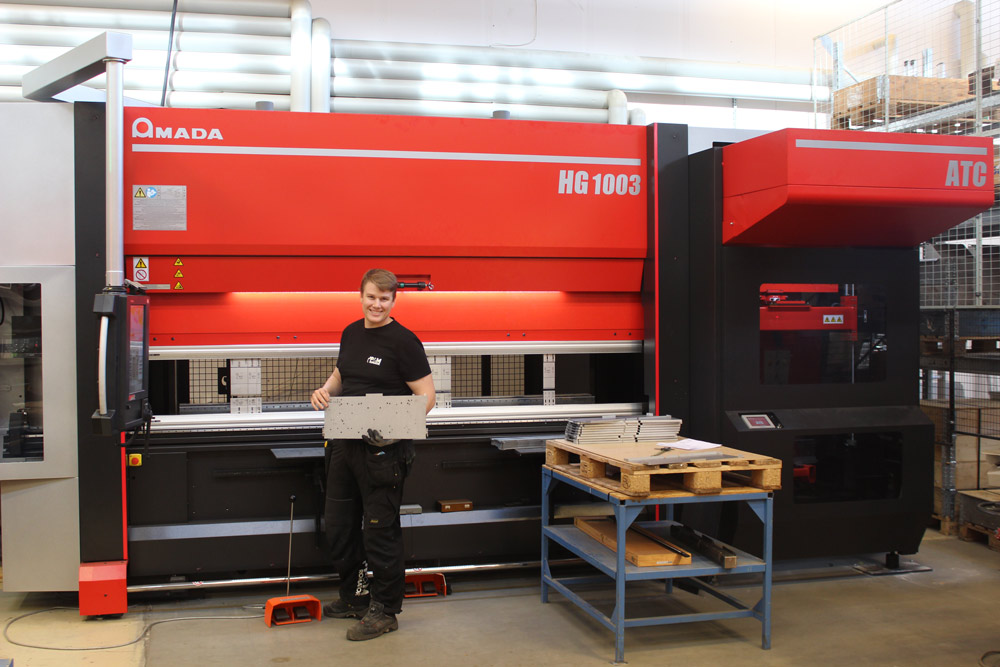Knowledge bank
Laser cutting is a common and highly flexible method used to precisely cut out shapes and patterns in sheet metal of different grades and thicknesses.

What is laser cutting?
Laser cutting is an advanced and precise cutting method that has revolutionised the sheet metal industry. This innovative technology uses a concentrated laser beam to cut through various materials, including metals such as steel and aluminium. By harnessing the energy of light, converted into intense heat, laser cutting can produce precise cuts with minimal impact on surrounding materials. This makes it particularly suitable for complex parts that were previously difficult or impossible to cut using conventional methods.
Laser cutting has not only improved the precision and efficiency of sheet metal processing, but has also opened up new design possibilities and product innovations.
How does laser cutting work?
Laser cutting works by focusing a high-intensity laser beam on the material to be cut. The beam generates so much heat that the material either melts or vaporises. A computer control moves either the laser head or the workpiece to create the desired pattern or shape. In the sheet metal industry, powerful CO2 lasers or fibre lasers are often used to cut through thicker materials.
The impact of laser cutting on the sheet metal industry
Laser cutting has had a profound impact on the sheet metal industry since its introduction. This technology has enabled a level of precision and efficiency that was previously difficult to achieve with traditional cutting methods. In today's fast-paced manufacturing industry, laser cutting has become a key component in meeting the increasing demands for fast delivery times and customised products. Companies that implement laser cutting, such as Plåt & Mekano Romator, can often offer shorter lead times, more complex designs and higher quality end products.
This has improved production processes and opened up new opportunities in product design and innovation. Many products we see in our everyday lives, from car parts to electronic housings, have become possible or more cost-effective to produce thanks to laser cutting. In addition, the technology has helped to reduce material waste and improve resource efficiency in industry, which is increasingly important in an era of growing focus on sustainability and environmental awareness.
Don't hesitate - get in touch with your questions!
Do you have any questions about our services or products? Just get in touch with one of our competent employees!
Contact us
What laser cutting can offer
- Laser cutting offers extremely high precision, often with tolerances of less than a tenth of a millimetre.
- The cutting speed can be up to tens of metres per minute, making the method very efficient.
- Laser cutting can be used on a wide variety of materials and thicknesses, up to 25 mm thick steel in modern machines.
- As the heat is concentrated on a very small surface, the rest of the material is minimally affected.
- Laser cutting offers a high quality of cut as it produces clean cuts with minimal slag formation.
- The technology enables the cutting of complex patterns and shapes with high precision.
Safety aspects
When using laser cutting equipment, safety is of utmost importance. Some important safety measures include:
- Ventilation: Adequate ventilation is necessary to manage smoke and vapours generated during the cutting process.
- Shielding: Laser cutting equipment should be properly shielded to prevent accidental exposure to the laser beam.
- Training: Operators must be properly trained in the safe use of the equipment.

Advantages and disadvantages of laser cutting
Advantages of the programme
- High precision and repeatability.
- Fast processing of complex shapes.
- Minimal material deformation.
- Possibility to cut in many different materials.
- Low noise level compared to mechanical cutting methods.
In addition to these benefits, there are several more advantages to choosing an experienced supplier like Plåt & Mekano Romator for laser cutting. Our expertise and modern equipment can contribute to optimised processes and high-quality results for your specific projects.
Disadvantages
- High initial investment costs for equipment.
- Limitations in material thickness, especially for some metals.
- Energy-intensive process.
- Requires specialised knowledge and training for operators.
- Potential safety risks if proper precautions are not taken.
Future prospects for laser cutting in the sheet metal industry
Laser cutting technology continues to evolve at a rapid pace, promising exciting prospects for the sheet metal industry. Advances in laser technology, such as the development of more energy-efficient and more powerful lasers, are expected to further improve cutting speeds and the ability to process thicker materials. The integration of artificial intelligence and machine learning into laser cutting systems is likely to lead to even higher precision and automation of complex cutting processes.
In addition, an increased use of hybrid technologies is foreseen, where laser cutting is combined with other processing methods to achieve even better results. This could potentially open up new application areas and material processing opportunities. With the growing focus on sustainability in industry, the development of more energy-efficient laser cutting systems and methods to minimise material waste is also expected.
Overall, laser cutting faces a promising future in the sheet metal industry, with the potential to continue driving innovation, efficiency and quality to new heights. Companies that keep up to date with these technological advances are likely to have a competitive advantage in the rapidly evolving manufacturing sector.
If you have more questions or concerns about what laser cutting is, you are welcome welcome to get in touch with us at Plåt & Mekano Romator, we are happy to help!


